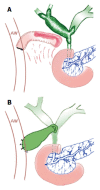Oddi sphincter preserved cholangioplasty with hepatico-subcutaneous stoma for hepatolithiasis
- PMID: 26668511
- PMCID: PMC4671042
- DOI: 10.3748/wjg.v21.i45.12865
Oddi sphincter preserved cholangioplasty with hepatico-subcutaneous stoma for hepatolithiasis
Abstract
Aim: To evaluate the long-term outcomes of Oddi sphincter preserved cholangioplasty with hepatico-subcutaneous stoma (OSPCHS) and risk factors for recurrence in hepatolithiasis.
Methods: From March 1993 to December 2012, 202 consecutive patients with hepatolithiasis underwent OSPCHS at our department. The Oddi sphincter preserved procedure consisted of common hepatic duct exploration, stone extraction, hilar bile duct plasty, establishment of subcutaneous stoma to the bile duct. Patients with recurrent stones can undergo stone extraction and/or biliary drainage via the subcutaneous stoma which can be incised under local anesthesia. The long-term results were reviewed. Cox regression model was employed to analyze the risk factors for stone recurrence.
Results: Ninety-seven (48.0%) OSPCHS patients underwent hepatic resection concomitantly. The rate of surgical complications was 10.4%. There was no perioperative death. The immediate stone clearance rate was 72.8%. Postoperative cholangioscopic lithotomy raised the clearance rate to 97.0%. With a median follow-up period of 78.5 mo (range: 2-233 mo), 24.8% of patients had recurrent stones, 2.5% had late development of cholangiocarcinoma, and the mortality rate was 5.4%. Removal of recurrent stones and/or drainage of inflammatory bile via subcutaneous stoma were conducted in 44 (21.8%) patients. The clearance rate of recurrent stones was 84.0% after subsequent choledochoscopic lithotripsy via subcutaneous stoma. Cox regression analysis showed that residual stone was an independent prognostic factor for stone recurrence.
Conclusion: In selected patients with hepatolithiasis, OSPCHS achieves excellent long-term outcomes, and residual stone is an independent prognostic factor for stone recurrence.
Keywords: Hepatectomy; Hepaticoplasty; Hepatolithiasis; Sphincter of Oddi; Stone recurrence.
Figures



Similar articles
-
Influence of endoscopic sphincterotomy on hepatolithiasis with Oddi sphincter-preserved cholangioplasty with hepatico-subcutaneous stoma: A three-decade, real word cohort study.J Hepatobiliary Pancreat Sci. 2025 Feb;32(2):168-176. doi: 10.1002/jhbp.12107. Epub 2025 Jan 13. J Hepatobiliary Pancreat Sci. 2025. PMID: 39801321
-
Long-term outcomes of surgical approaches for bilateral hepatolithiasis: A real-world six-decade experience at a single center.J Hepatobiliary Pancreat Sci. 2022 Sep;29(9):994-1003. doi: 10.1002/jhbp.1204. Epub 2022 Jul 6. J Hepatobiliary Pancreat Sci. 2022. PMID: 35794790
-
Laparoscopic hepaticoplasty using gallbladder as a subcutaneous tunnel for hepatolithiasis.World J Gastroenterol. 2014 Mar 28;20(12):3350-5. doi: 10.3748/wjg.v20.i12.3350. World J Gastroenterol. 2014. PMID: 24695884 Free PMC article.
-
Clinical prospect of applying the chemical bile duct embolization to achieve a chemical hepatectomy in the treatment of highly selected hepatolithiasis.Surg Laparosc Endosc Percutan Tech. 2009 Jun;19(3):183-7; discussion 187-9. doi: 10.1097/SLE.0b013e3181a81de5. Surg Laparosc Endosc Percutan Tech. 2009. PMID: 19542840 Review.
-
Biliary tract exploration via left hepatic duct stump versus the common bile duct incision in left-sided hepatolithiasis: a meta-analysis.ANZ J Surg. 2021 Jul;91(7-8):E439-E445. doi: 10.1111/ans.16856. Epub 2021 Apr 12. ANZ J Surg. 2021. PMID: 33844407 Review.
Cited by
-
Nomogram predicting surgical risk of laparoscopic left-sided hepatectomy for hepatolithiasis.Langenbecks Arch Surg. 2023 Sep 13;408(1):357. doi: 10.1007/s00423-023-03099-6. Langenbecks Arch Surg. 2023. PMID: 37704787 Clinical Trial.
-
Correlation analysis and recurrence evaluation system for patients with recurrent hepatolithiasis: a multicentre retrospective study.Front Digit Health. 2024 Nov 27;6:1510674. doi: 10.3389/fdgth.2024.1510674. eCollection 2024. Front Digit Health. 2024. PMID: 39664398 Free PMC article.
References
-
- Li SQ, Liang LJ, Peng BG, Hua YP, Lv MD, Fu SJ, Chen D. Outcomes of liver resection for intrahepatic stones: a comparative study of unilateral versus bilateral disease. Ann Surg. 2012;255:946–953. - PubMed
-
- Tan J, Tan Y, Chen F, Zhu Y, Leng J, Dong J. Endoscopic or laparoscopic approach for hepatolithiasis in the era of endoscopy in China. Surg Endosc. 2015;29:154–162. - PubMed
-
- Yang T, Lau WY, Lai EC, Yang LQ, Zhang J, Yang GS, Lu JH, Wu MC. Hepatectomy for bilateral primary hepatolithiasis: a cohort study. Ann Surg. 2010;251:84–90. - PubMed
-
- Vetrone G, Ercolani G, Grazi GL, Ramacciato G, Ravaioli M, Cescon M, Varotti G, Del Gaudio M, Quintini C, Pinna AD. Surgical therapy for hepatolithiasis: a Western experience. J Am Coll Surg. 2006;202:306–312. - PubMed
-
- Lai EC, Ngai TC, Yang GP, Li MK. Laparoscopic approach of surgical treatment for primary hepatolithiasis: a cohort study. Am J Surg. 2010;199:716–721. - PubMed
MeSH terms
LinkOut - more resources
Full Text Sources
Other Literature Sources
Medical

